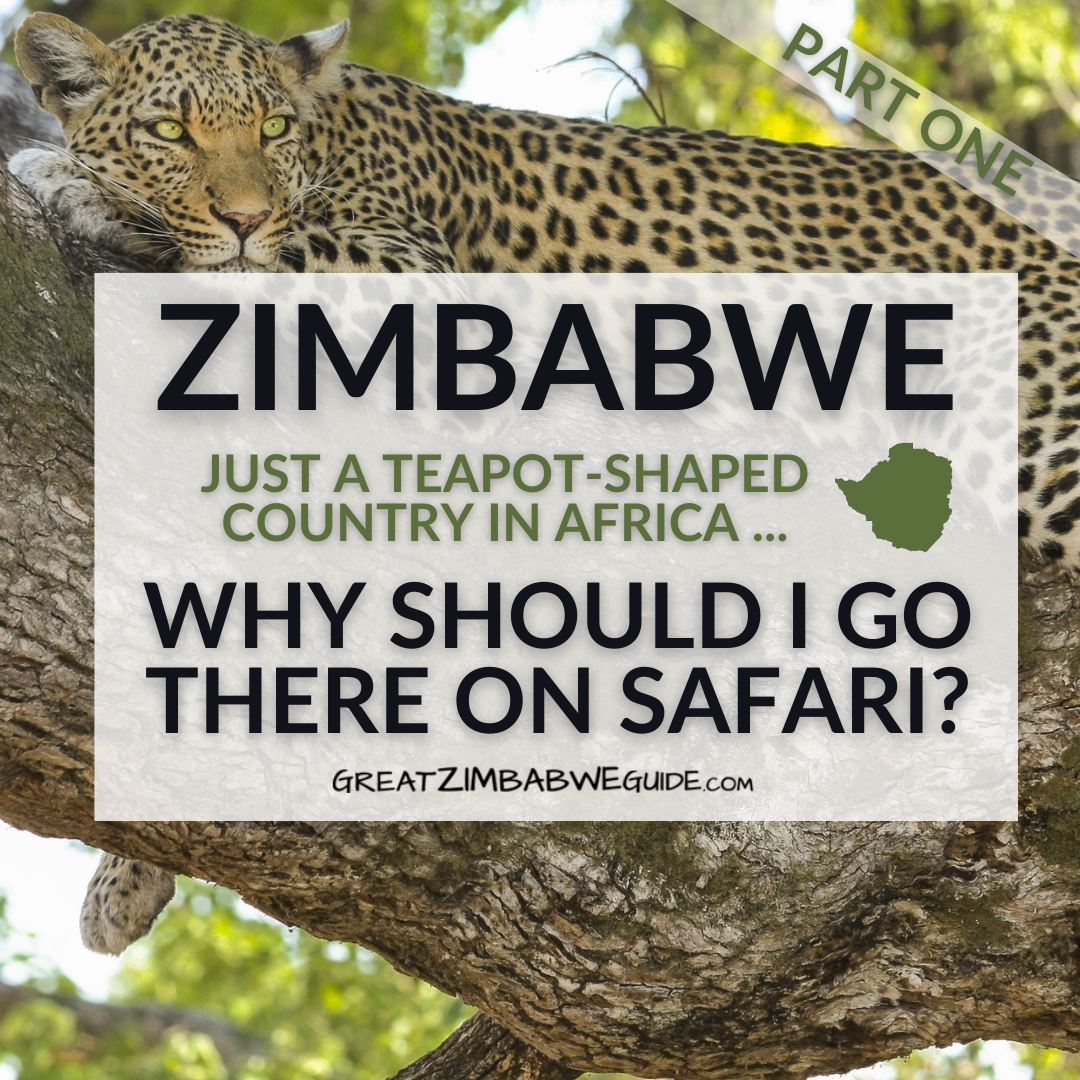
Zimbabwe, just a teapot-shaped country in Africa: Why should I go there on Safari? (Part one)
Written by Beth
It goes without saying that I think Zimbabwe is an AMAZING place to go on safari. This website wouldn’t exist otherwise! While Zimbabwe might not be the biggest or most popular destination in Africa, it’s a big hitter when it comes to natural treasures.
Some news headlines about Zimbabwe’s political and economic woes have meant that Zimbabwe is sometimes overlooked as a safari holiday option, but this would be a mistake.
If you take a closer look at Zimbabwe, you’ll find authentic wildernesses where you can avoid crowded tourist traps and focus on what you came for: the wildlife and soul-nourishing landscapes.
Why should you seriously consider adding Zimbabwe to your African safari itinerary?
Here are just a few reasons …
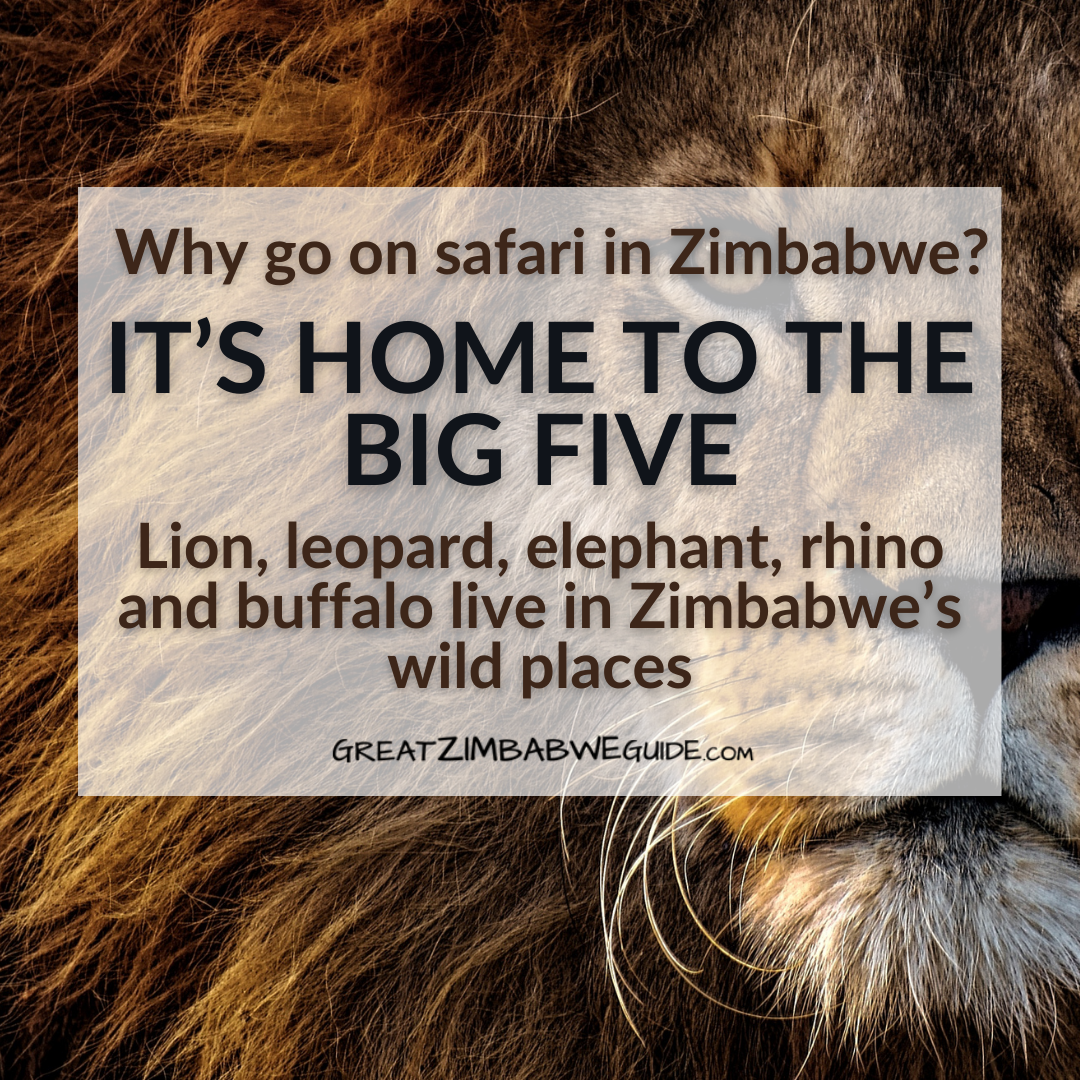
1. Zimbabwe is home to the Big Five
The legendary African Big Five are the lion, leopard, elephant, white rhino and Cape buffalo. They were called the Big Five because they were considered the biggest and most dangerous animals to hunt, but safari-goers today usually prefer to shoot these magnificent creatures with their cameras. The Big Five animals roam freely in many of Zimbabwe’s wild places, as well as in protected large fenced zones.
While you shouldn’t have a ‘checklist’ mentality, or take any wildlife sightings for granted, the Big Five is a key part of the African safari dream. Head to Gonarezhou National Park or Hwange National Park if you want to see all the Big Five in one (large) area – but note that the rhino in Hwange can only be seen as part of the Hwange Community Rhino Conservation Initiative. Otherwise, have a look at our infographics to check out which of Zimbabwe’s National Parks are home to which of the Big Five. I recommend an itinerary including Victoria Falls, Hwange and Matobo.
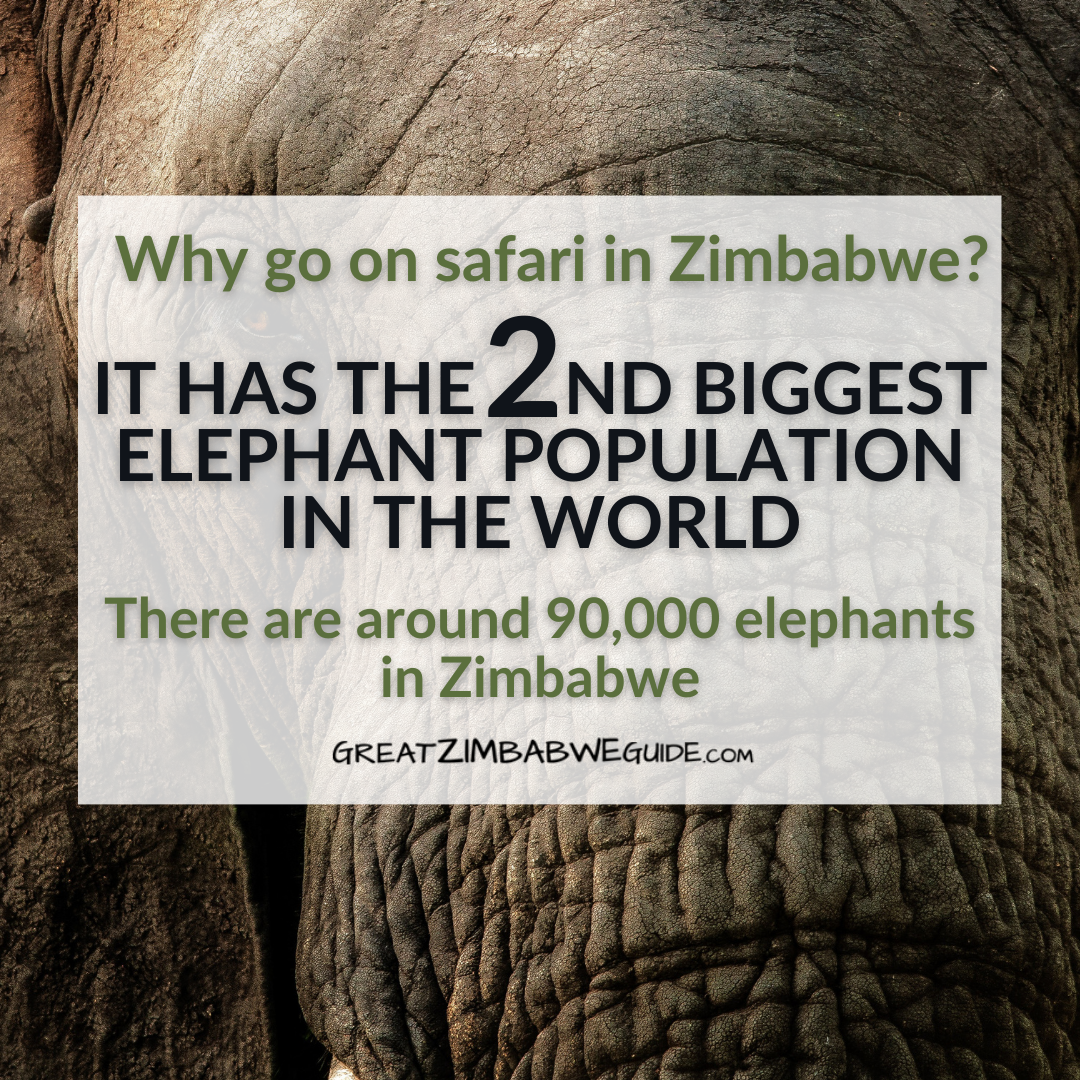
2. Zimbabwe has the 2nd biggest elephant population in the world
There are around 90,000 elephants roaming in Zimbabwe, which is astounding considering their size, eating habits and migratory patterns. African elephants are bigger than Asian elephants, and they aren’t usually tamed in the same way as in Asia. These are five-tonne gentle giants that live in large herds and walk up to 195 km a day. Although they mostly live in conservation areas, these aren’t usually fenced, so elephants in Zimbabwe cross international borders to and from Botswana, South Africa and other neighbouring countries.
If you want to see large herds of elephant in Zimbabwe that will leave you astounded, go to Hwange National Park. However, most National Parks in Zimbabwe are home to good populations of elephant (except Matobo, Nyanga and Chimanimani), and there are so many that you’re almost guaranteed to see elephant while you’re in the country. For something different to the age-old game drive, go to Matusadona National Park or Mana Pools National Park where you can see elephants from the vantage point of the water, too. See some of my photos from Matusadona here. Read my post about wild camping among elephants in Mana Pools here.
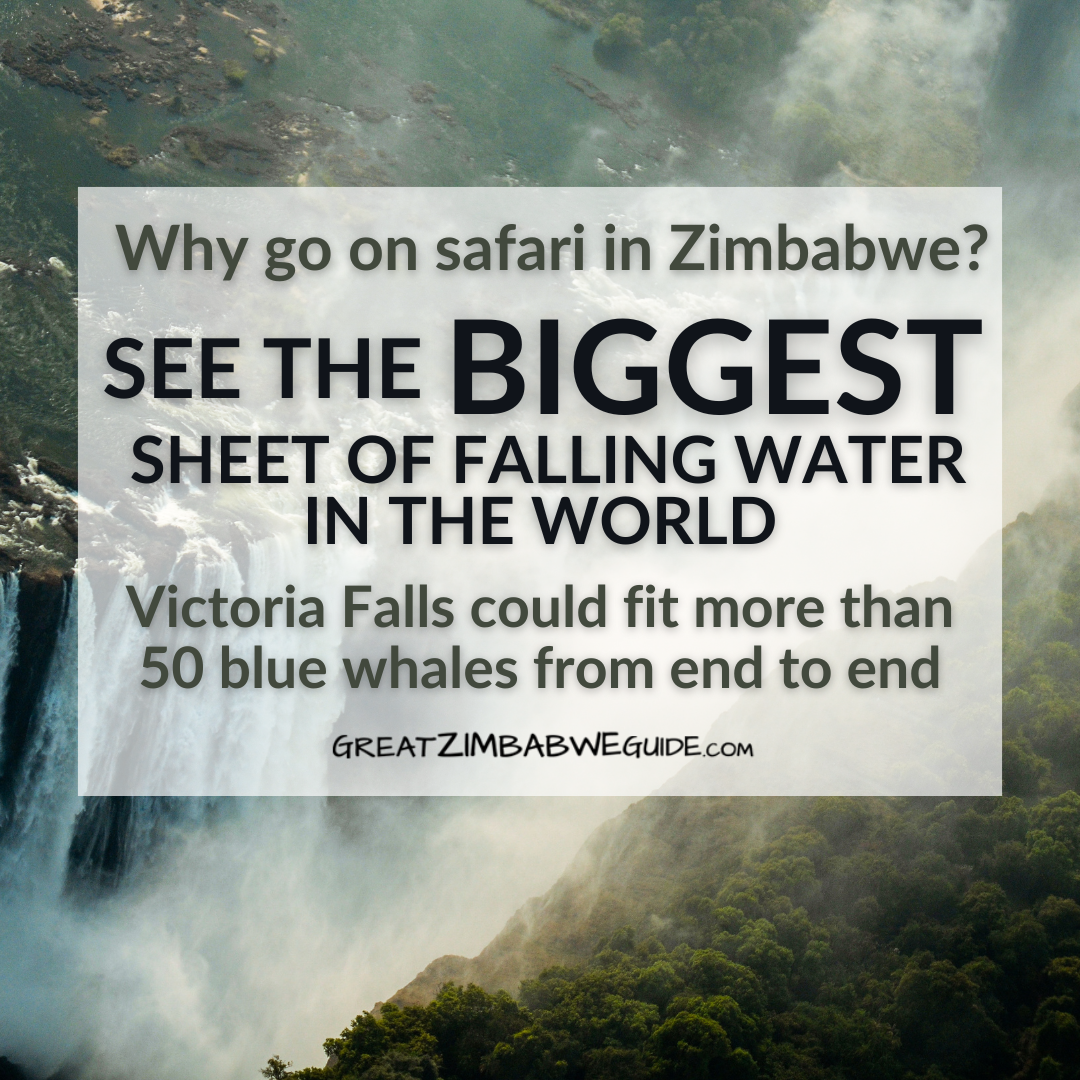
3. See the biggest sheet of falling water in the world in Zimbabwe
Victoria Falls is the largest waterfall in the world by some calculations, with a combined width and height of 1700m by 108m. More than 50 blue whales could fit between one end of the Falls and the other [source].
It’s also one of the Seven Natural Wonders of the World and has World Heritage Site status from the United Nations (UN). This massive sheet of falling water can’t be taken in from one viewing point – you have to keep on walking along the cliff face, under the canopy of a rainforest, to see the whole thing. All the while, the sound of thunder pounds in your ears – the sound of the falling water crashing against the rocks below.
The town closest to the waterfall in Zimbabwe is also called Victoria Falls. The town on the other side of the waterfall, in the country of Zambia, is called Livingstone. You can walk along two-thirds of the viewing points from the Zimbabwean side rather than the Zambian side. With a huge number of accommodation options plus an enticing variety of activities, eateries and entertainment in this area of the Zambezi River, Victoria Falls should be on everyone’s African safari itinerary!
Read more about visiting Victoria Falls (the waterfall) here. Top tip: Bear in mind that the flow rate of the falls go through regular ‘high’ and ‘low’ seasons across the year. If you want to see the Victoria Falls in full power, go between March and May. If your main reason to visit is for the white water-rafting, go between August and early January. Read our article on Everything you need to know about Victoria Falls here.
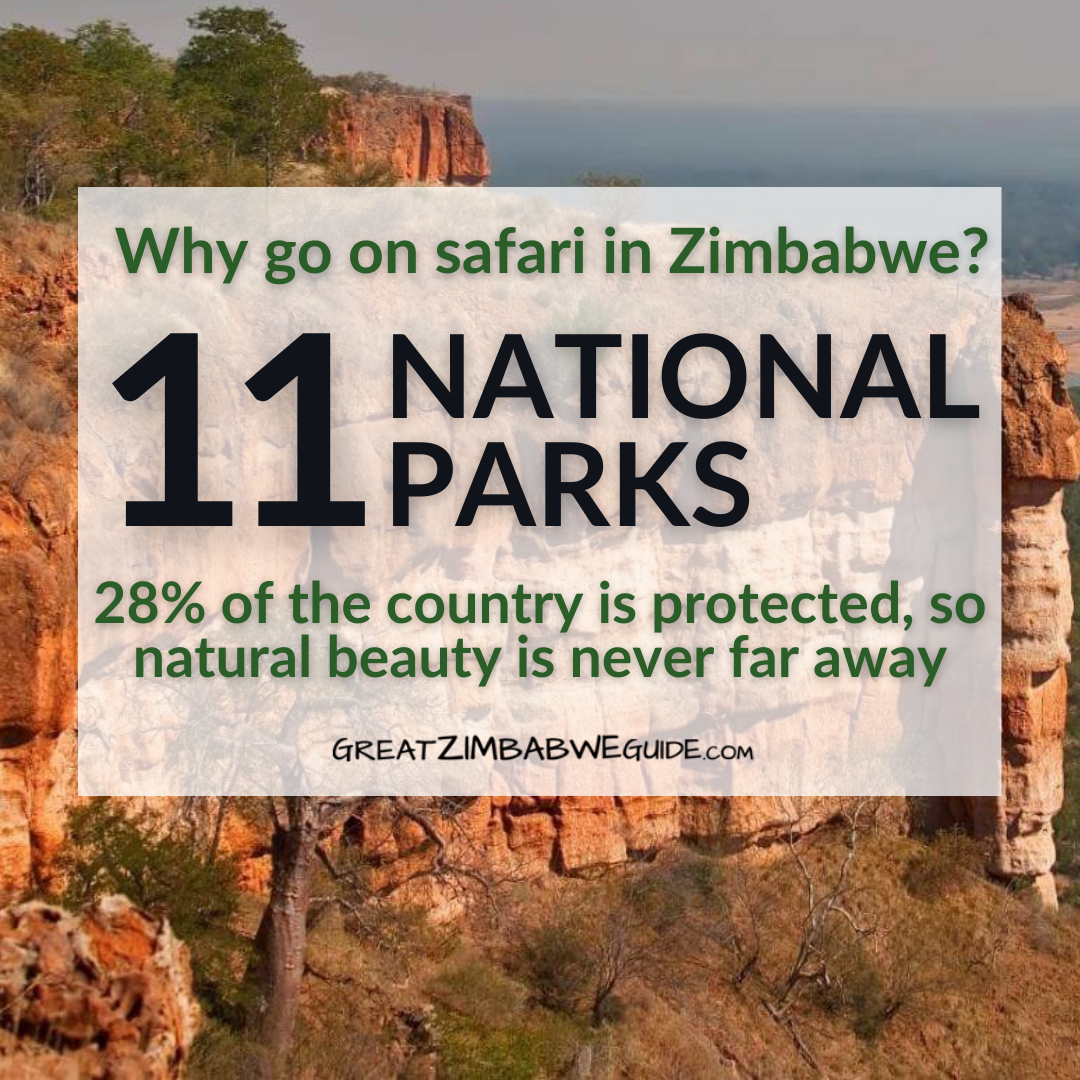
4. Zimbabwe has 11 National Parks
28% of the country is under the National Parks Authority [source], which means that you’re never far away from “the bush” here. The National Parks in Zimbabwe were created as conservation areas to protect wildlife, ecosystems and natural beauty: there are hundreds of species of birds and animals in all of them, although some National Parks are more wild than others. The Parks are mostly unfenced, which means that the animals roam freely, and you really feel like you’re in the “real” African wilderness. While there aren’t usually fences around the Parks, accommodation and lodges within the Parks can either have a fence around them, so that guests can sleep in peace, or they can be unfenced – you can choose how wild you go!
Here are Zimbabwe’s 11 National Parks (and a quick reason to visit each for a safari)
- Mana Pools: Go here for a ‘pure’ safari, away from tarred roads and the crowds. See elephant, lion and painted dog on floodplains near the Zambezi River. Read my post about wild camping among elephants in Mana Pools here.
- Matusadona: Go here to see elephant and hippo against dramatic backdrops of petrified trees in a vast lake and the Matusadona Mountains beyond. See some of my photos from Matusadona here.
- Chizarira: Go here for a remote break to see elephant and buffalo among thick woodlands and deep escarpments.
- Victoria Falls: Go here to see the thundering, jaw-dropping Victoria Falls waterfall. Read our article on Everything you need to know about Victoria Falls here.
- Zambezi: Go here to spot lion and elephant close to the town of Victoria Falls, against the backdrop of the Zambezi River. Read our article on Everything you need to know about Victoria Falls here.
- Kazuma Pan: Go here for wild camping in lion territory.
- Hwange: Go here to see enormous herds of elephant roaming freely amidst a plethora of other wildlife.
- Matobo: Go here to hike up huge rock-mountains, see ancient cave paintings and to spot rhino. See some of my photos of Matobo here.
- Gonarezhou: Go here to see elephants walking against the backdrop of the red Chilojo Cliffs.
- Chimanimani: Go here to hike in lush green Afro-montane forests.
- Nyanga: Go here for a break to the “Scottish highlands of Zimbabwe”: cosy cottages with wood fires and forest walks.
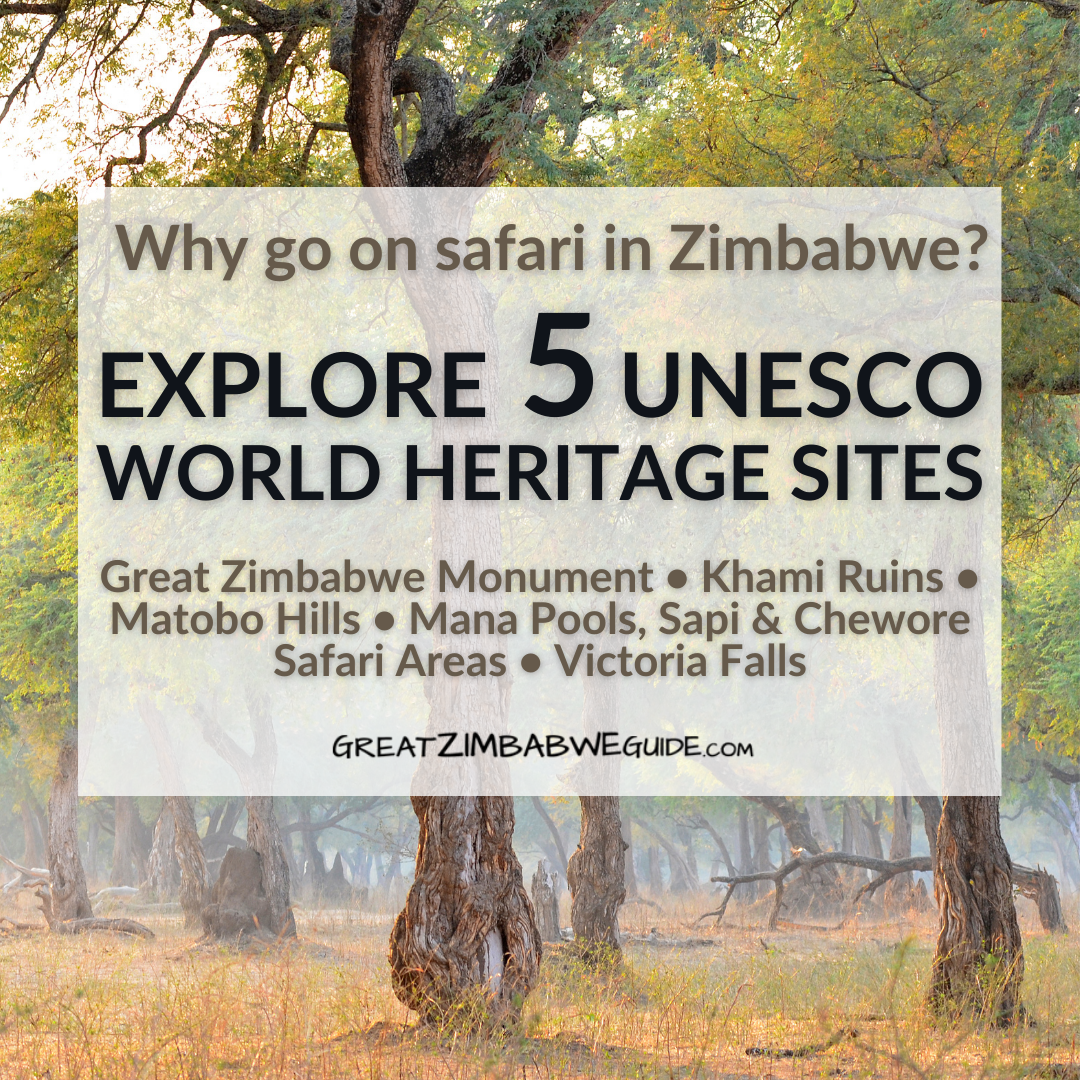
5. Explore five UNESCO World Heritage Sites in Zimbabwe
Areas in the world with “outstanding universal value” are inscripted with World Heritage status by The United Nations Educational, Scientific and Cultural Organization (UNESCO). There are many areas of Zimbabwe that are extremely beautiful or have deep cultural importance, but the sites that have been added to the World Heritage List are ones deemed to be significant not just to locals, but to people from anywhere in the world. This is your sign to visit them!
Here are the five UNESCO World Heritage Sites in Zimbabwe (and the reasons for inscription)
- Great Zimbabwe Monument (near Masvingo)
- This great ancient city has struck the imagination of African and European travellers since the Middle Ages for its unique artistic architectural achievements, and it has persistent legends which attribute to it a Biblical origin and the Queen of Sheba.
- The ruins of Great Zimbabwe bear a unique testimony to the civilisation and history of the Shona between the 11th and 15th centuries.
- The “Zimbabwe bird” stone carving found at the site, which may have been a royal totem, has become a symbolic emblem for the identity of the Zimbabwe nation as a whole.
- Read our article Everything you need to know about Great Zimbabwe Monument here.
- Khami Ruins (near Bulawayo)
- The stone ruins are a unique and exceptional testimony to a civilization which has disappeared. The architecture and archaeological artefacts of the site provide important scientific and historical evidence critical for the understanding of the full chronological development of the Zimbabwe tradition from the Stone Age to the Iron Age era.
- They are an outstanding example of a type of building and architectural ensemble which illustrates a significant stage in history. It has shown an exceptional long evidence related to human evolution and human environment dynamics, collectively extending from 100 000 years ago to date, and demonstrates testimonial to the long distance trade from this area to the outer world.
- Read my travel journal about Khami Ruins here.
- Matobo Hills (near Bulawayo)
- These granite hills have one of the highest concentrations of rock art in southern Africa. The rich evidence from archaeology and from the rock paintings provide a very full picture of the lives of foraging societies in the Stone Age and the way agricultural societies came to replace them.
- The living cultural traditions associated with the religious shrines in the hills date back to the Iron Age. They represent one of the most powerful intangible oracular traditions in southern Africa that dates back 100,000 years, and one that could be said to be of universal significance.
- See some of my photos of Matobo here.
- Mana Pools, Sapi & Chewore Safari Areas (in northern Zimbabwe)
- The annual congregation of animals along the broad Zambezi River constitutes one Africa’s outstanding wildlife spectacles.
- The ‘sand-bank’ environment constitutes a good example of erosion and deposition by a large seasonal river (despite changes in river flow due to the Kariba Dam). There is a clear pattern of vegetation succession on the alluvial deposits. Seasonal movements of large mammals within the valley are of great ecological interest both because of interspecies and intraspecies differences.
- An important refuge for wildlife, plants and birds. At time of inscription the area was one of the most important refuges for black rhino in Africa as well as a number of other species considered threatened. Today, the black rhino has now disappeared here, but the area still contains important populations of elephant, hippopotamus, lion, cheetah, wild dog, leopard, brown hyena, and Nile crocodile, which require protection.
- Read my post about wild camping among elephants in Mana Pools here.
- Victoria Falls (in north Zimbabwe, near the town of Victoria Falls, and in south Zambia, near the town of Livingstone)
- The Mosi-oa-Tunya/Victoria Falls is the world’s greatest sheet of falling water and significant worldwide for its exceptional geological and geomorphological features and active land formation processes with outstanding beauty attributed to the falls: the spray, mist and rainbows.
- It is the largest curtain of falling water in the world; it is 1708 m wide. Up to 500 million litres per minute fall at the following sections of the waterfall: 61 m (Devil’s Cataract), 83 m (Main Falls), 99 m (Rainbow Falls), 98 m (Eastern Cataract). Eight spectacular gorges of igneous origin and several islands in the core zone are breeding sites for endangered and migratory bird species, such as the Taita Falcon and Black Eagle.
- The riverine ‘rainforest’ within the waterfall splash zone is a fragile ecosystem of discontinuous forest, dependent upon abundant water and high humidity provided by the spray that rises about 500 m (at maximum height) that can be seen from a distance of 50 km and 30 km from Bulawayo and Lusaka roads respectively.
- Eight gorges have been formed through the changing waterfall positions over a geological time scale. The gorges are an outstanding example of river capture and the erosive forces of the water which still continue to sculpture the hard rock. These gorges zigzag over a distance of about 150 km along the Zambezi River below the falls. Seven previous waterfalls occupied the gorges below the present falls, and the Devil’s Cataract in Zimbabwe is the starting point for a future waterfall. Upstream are a spectacular series of riverine islands formed during the ongoing geological and geomorphological processes.
- The area has revealed artefacts of Homo habilis dating three million years, stone tools of the middle Stone Age and weapons, adornments and digging tools of the late Stone Age that indicate occupation by hunter-gatherers.
- Read more about visiting Victoria Falls (the waterfall) here. Read our article on Everything you need to know about Victoria Falls here.
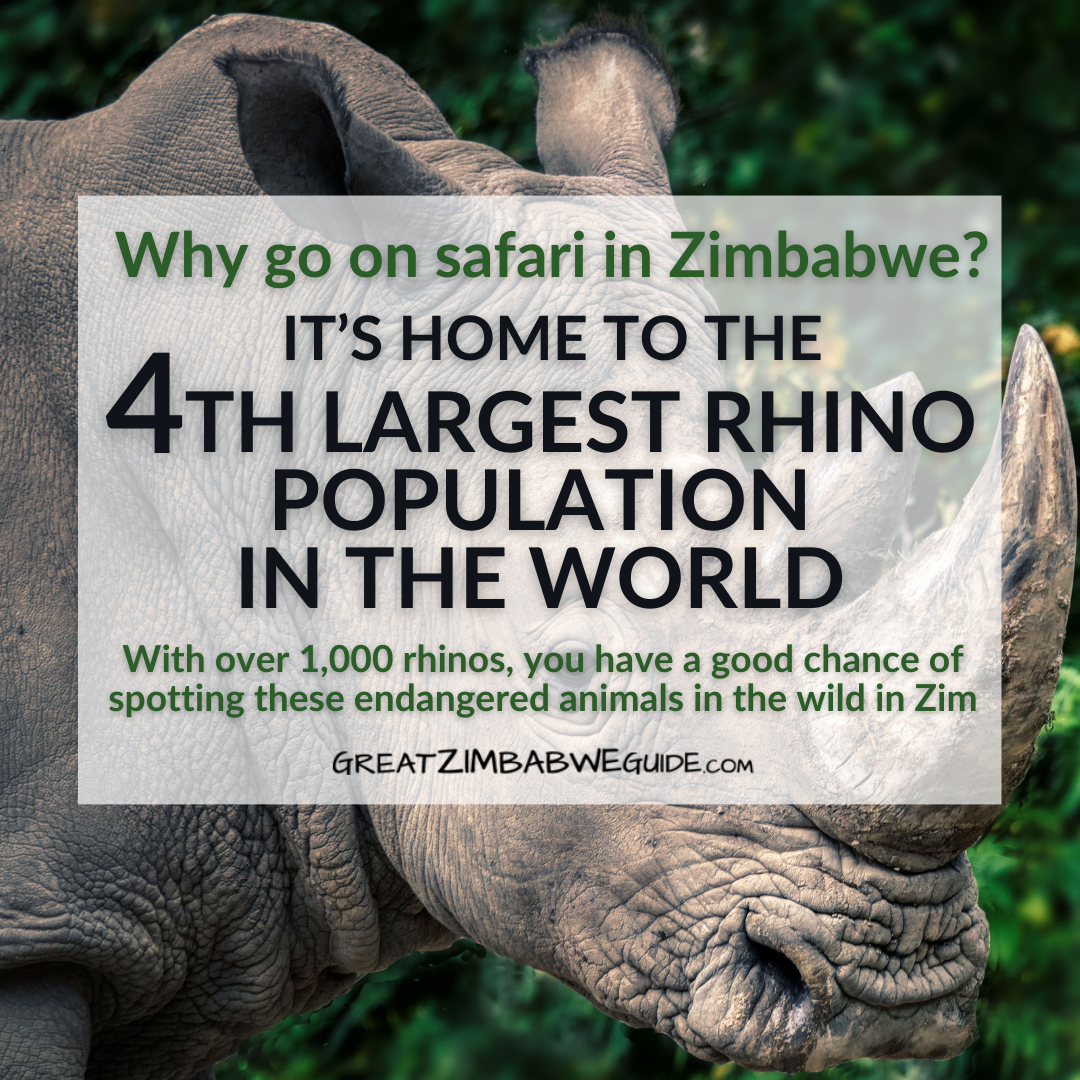
6. Zimbabwe is home to the fourth largest rhino population in the world
With over 1,000 rhinos, you have a good chance of spotting these endangered animals in Zimbabwe. There are approximately 616 black rhinos and 417 white rhinos in Zimbabwe [source]. Many rhinos in Zimbabwe now have their horns ‘filed’ down humanely, to deter poachers from killing them and cutting out their horns for illegal overseas trading.
Zimbabwe’s Lowveld region (including Malilangwe, the Bubye Valley Conservancy, the Save Valley Conservancy and Gonarezhou National Park) is home to nearly 90% of the country’s rhino population, so this is one of the best areas to go to see rhino. You can also see them in Matobo National Park, and on the outskirts of Hwange National Park with the Community Rhino Conservation Initiative (and Imvelo Lodges). If your heart is set on spotting a rhino, it’s best to visit the above areas and to stay in a luxury lodge (which means a specialised safari guide), or independently book an experienced rhino safari guide to help you find these well-camouflaged creatures. Although rhinos are big, there are many rocks in Zimbabwe that can be mistaken for a rhino at first glance!
Top tip for self-drivers on a budget to see rhino: Go to Lake Kyle Recreational Park (near Great Zimbabwe Monument) or Lake Chivero Recreational Park (near Harare). If you’re lucky you could spot rhino from your own vehicle without a guide and pay lower entrance fees than a National Park.
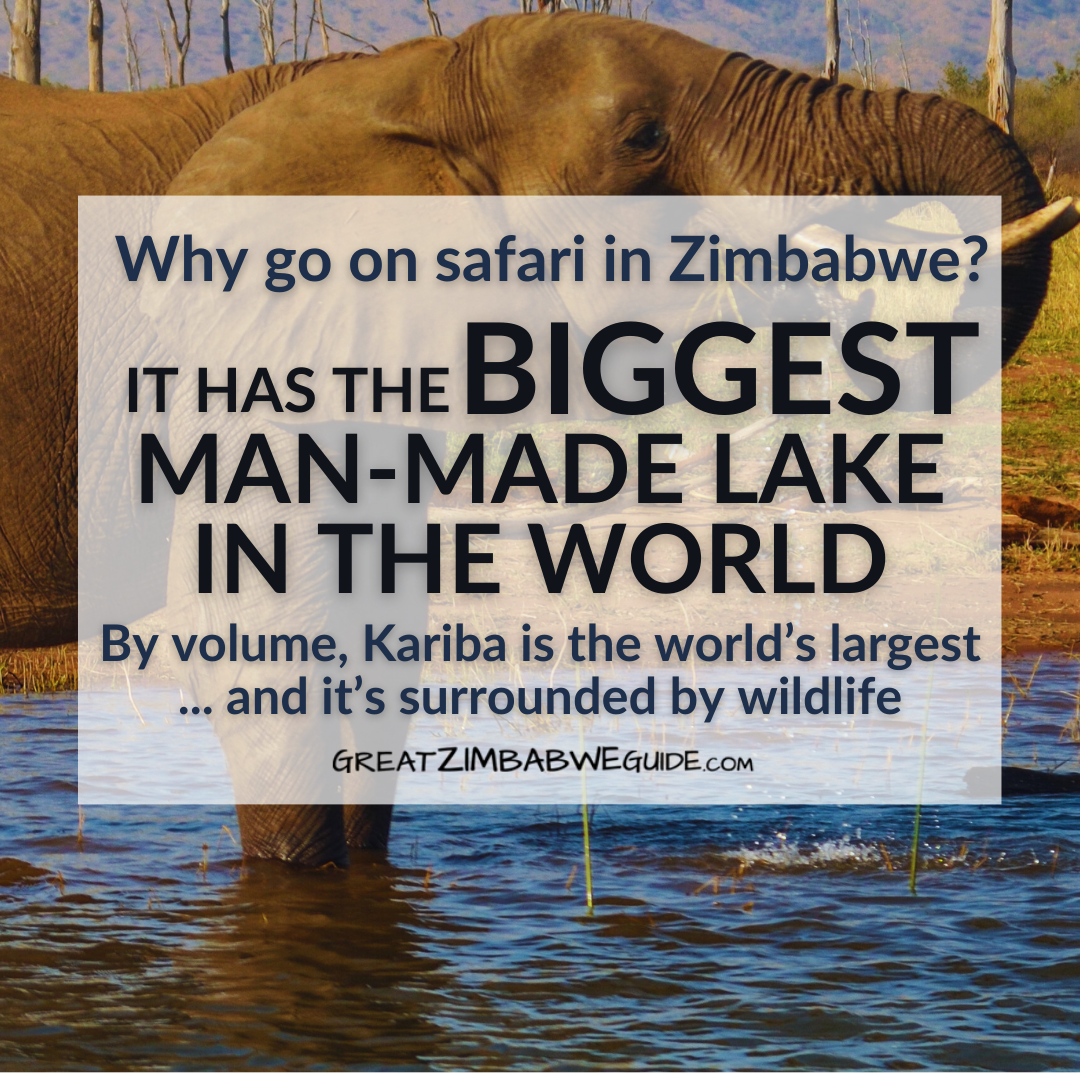
7. Zimbabwe has the biggest man-made lake in the world
… and it’s teeming with wildlife!
By volume, Kariba is the world’s largest reservoir [source] … and it is home to thousands of animals. A section of the mighty Zambezi River was transformed into a massive reservoir in 1959, using the natural landscape of the valley in the Kariba gorge, and a dam wall to contain and control the water levels.
Many people will marvel at this feat of engineering, and justifiably so, but the majority of visitors (including myself) revel in Kariba for its natural, rather than its man-made, sights. Groups of elephant drink from its long shoreline, hippo graze on the banks and islands, and lions hunt buffalo in the shadow of the nearby Matusadona mountains.
Lake Kariba is the closest thing Zimbabwe has to a sea, although swimming is definitely not advised here. (I may have disregarded this advisory in the past.) It’s one of the few places on earth where you can stay in one of the lodges or one of the many houseboats, and then hire an experienced guide to go on a speedboat trip to view crocodile, elephant, hippo and more from a watery vantage point. This is one of my favourite places in Zimbabwe, and shouldn’t be overlooked. See some of my photos from Matusadona here.
Those are my top seven reasons to visit Zimbabwe on your African safari …
I hope that’s enough to inspire you to consider adding Zimbabwe to your African safari itinerary. And I can think of many more reasons – so stay tuned for Part 2 of this post coming up!
For first-time visitors to Zimbabwe, I’d recommend going to Victoria Falls first. It’s extremely visitor friendly and has been welcoming international guests for decades. Walk along “the falls” and go on a safari river cruise on the Zambezi, perhaps squeezing in a gorge swing if you’re an adrenalin lover. I’d recommend at least 2 nights in Victoria Falls.
Then, why not get a transfer to Hwange National Park to see huge herds of elephants and more (for at least 3 nights). If you have time, head to Matobo National Park to hike in the vast rocky landscapes, see Stone Age rock paintings and maybe even a rhino or two.
For packaged tours, there are many amazing agencies out there! One of them is Lucky Bean Travel.
Great Zimbabwe Guide gives travel tips, information and inspiration about Zimbabwe, Africa. We share stories of Zimbabwe’s talented people, world-class wilderness & wildlife safari experiences, all wrapped up in an unmatched climate.
Do you have a question about visiting Zimbabwe? Start with the Quick-reference list of travel advice.
Follow Great Zimbabwe Guide on social media for even more Zimbabwe travel tips and inspiration: Facebook (@GreatZimbabweGuide) & Instagram(@GreatZimGuide).
To ensure you don’t miss anything, sign up for email newsletters on our Contact page.
Lucky Bean Travel is an owner-run travel specialist agency, based in Victoria Falls, Zimbabwe. Caroline has vast experience in Zimbabwe travel, and her priority is ensuring you have the best holiday possible, no matter your budget. Click here to discuss your dream Zimbabwe holiday with Caroline today. Alternatively, just email her at [email protected]. (Lucky Bean is one of our trusted affiliates.)
What’s one thing you absolutely need for an African safari? A good hat. I’ve bought this Walker and Hawkes Canvas Outback Stanley Hat in Olive from Amazon and I absolutely love it! (aff link)

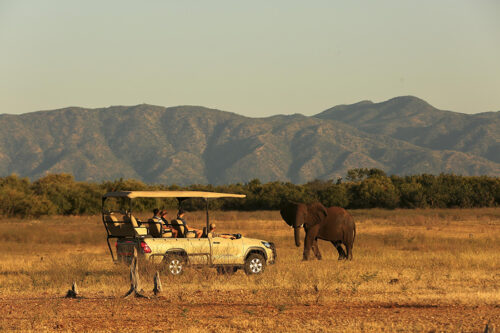
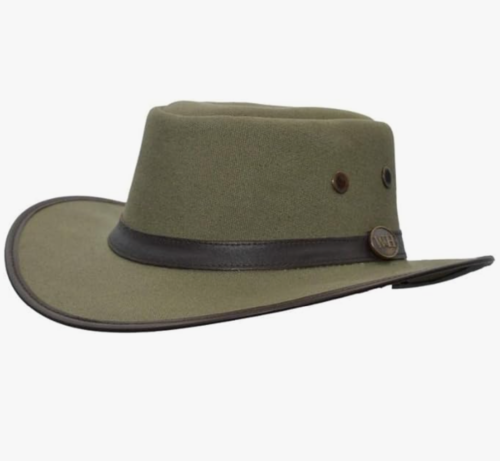

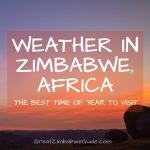
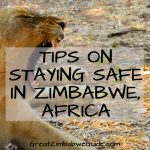



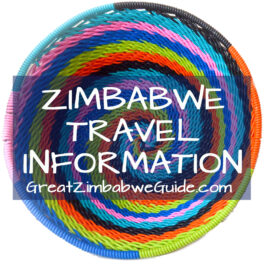
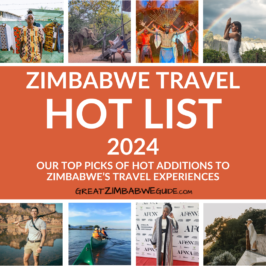
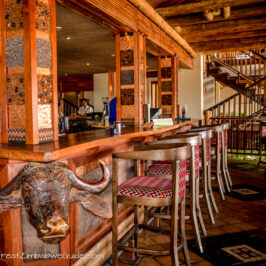
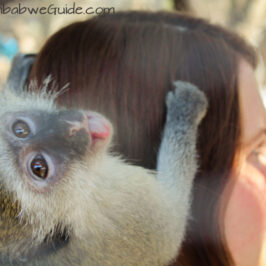

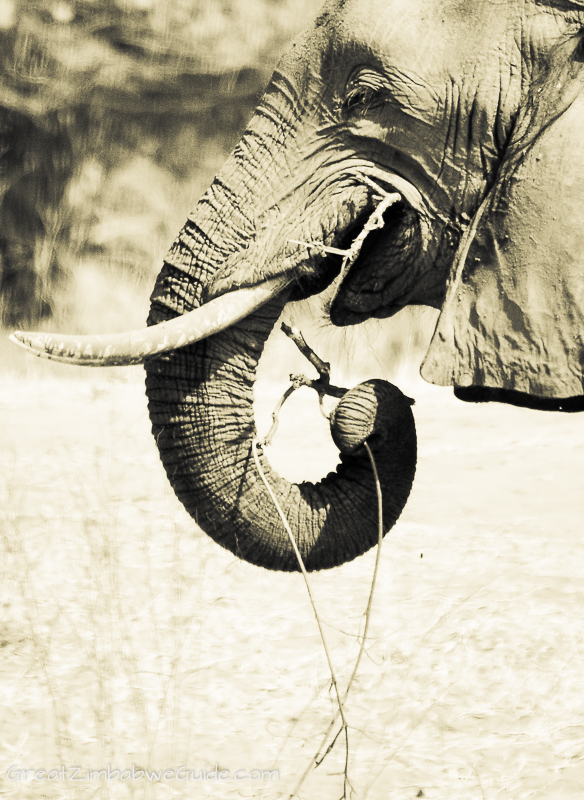
Leave a Reply